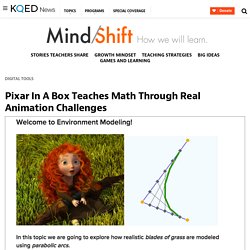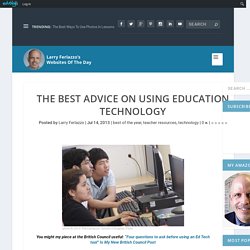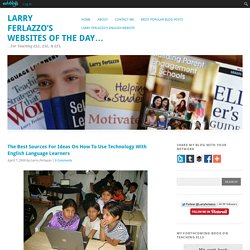

Periodic Table of Storytelling. Educator's guide. Pixar In A Box Teaches Math Through Real Animation Challenges. Pixar senior scientist Tony DeRose was faced with a problem that animators had never solved — how to make the hand of an old man look lifelike.

It was 1998 and he was working on the experimental short film “Geri’s Game.” DeRose needed to figure out how to make a sculpture hand model with many angular planes look smooth and skin-like on the screen. To do this he developed an algorithm using weighted averages that won him a Scientific and Technical Academy Award in 2006. Pixar is constantly solving new technical challenges that allow its artists, designers and storytellers a broader range of movement and texture in the movies they make. Now the company is teaming up with Khan Academy to use examples like DeRose’s discovery of surface representation to show students how the math and science they’re learning in school is applied by Pixar animators.
“The place we intersected was this need to pull people in,” Cruise said. “They have this more interactive intuition lesson,” Cruise said.
_EDU-WKP(2013)_ Sparking Innovation in STEM education. OECD_EDU-WKP(2013)_ Sparking Innovation in STEM education. Educationtoday: Are schools ready to join the technological revolution? By Andreas SchleicherDirector, Directorate for Education and Skills When it comes to technology, education seems stuck in the age of chalkboards.

But at an international conference on technology in education, held in Qingdao, China, last week, I got the feeling that educators and education ministers might finally be ready to join the technological revolution. Right now, at a moment when information and communication technologies are changing the way we live in both subtle and not-so-subtle ways, only around 37% of schools in Europe have high-end equipment and high-speed Internet connectivity, a figure which ranges from 5% in Poland to virtually 100% in Norway.
But when asked, between 80% and 90% of school principals say that their schools are adequately equipped when it comes to computers and Internet connectivity – even principals in the many countries where the equipment is clearly substandard. So is technology not that important? The situation is even more puzzling than that. Fairfield County School District has gone Google. New OECD Report Is Not An Indictment Of Ed Tech – It’s Really An Indictment Of Unilateralism & Professional Development. The Best Advice On Using Education Technology. You might my piece at the British Council useful: “Four questions to ask before using an Ed Tech tool” Is My New British Council Post Q&A Collections: Using Tech in the Classroom is the headline of one of my Education Week Teacher columns.

It includes links to all my Ed Week posts on using tech in the classroom from the past seven years – in one place! During this past week, I’ve been lucky enough to see the two best posts I know of offering great advice on how to use educational technology. I thought I’d bring them together in one post, along with links to some of my related “The Best” lists, and invite readers to contribute other resources, too. You may have already seen Bill Ferriter’s image, Technology is a Tool, NOT a Learning Outcome. Here’s another great graphic from Bill: You may, however, not have seen Frank Noschese’s absolutely brilliant post on Edtech PR Tips. Digital Worksheets is by John Spencer. The Best Places To Find Research On Technology & Language Teaching/Learning. As a strong believer in and practitioner of using technology in language teaching, I thought it would be useful to bring together a list of resources providing research on its effectiveness.

I hope readers will make additional suggestions. Here are my choices for The Best Places To Find Research On Technology & Language Teaching/Learning: The European Association for Computer-Assisted Language Learning has lots of resources. The ICT4LT Project also has a number of good materials. Foreign Language Teaching Methods- Technology comes from the University of Texas. We’ve also done quite a bit of research here in Sacramento. My “Take” On Recent Study Saying Home Computer Usage Can Lead To Lower Test Scores Family Literacy Project Update Newest Assessment Results From Family Literacy Project Latest Assessment Results From Family Literacy Project.
The Best Sources For Ideas On How To Use Technology With English Language Learners. This is going to a relatively short “The Best…” list sharing places where ESL/EFL/ELL teachers who are both new and experienced with using educational technology can find resources, ideas, and support.

Here are my picks for The Best Sources For Ideas On How To Use Technology With English Language Learners (not in order of preference): A video from Nik Peachey called Web 2.0 For EFL/ESL Teachers. In addition, Nik has three excellent blogs focusing on using technology with ELL’s. He’s just put together a second video and e-book with a similar name — Web 2.0 Tools For EFL ESL Teachers. A good slideshow presentation titled Using Web Logs In The EFL Class. Language Learning And Web 2.0, a video by Graham Stanley. The “The Best…” lists I’ve compiled and some articles that I’ve written. The Best Sources For Ideas On How To Use Technology With English Language Learners.